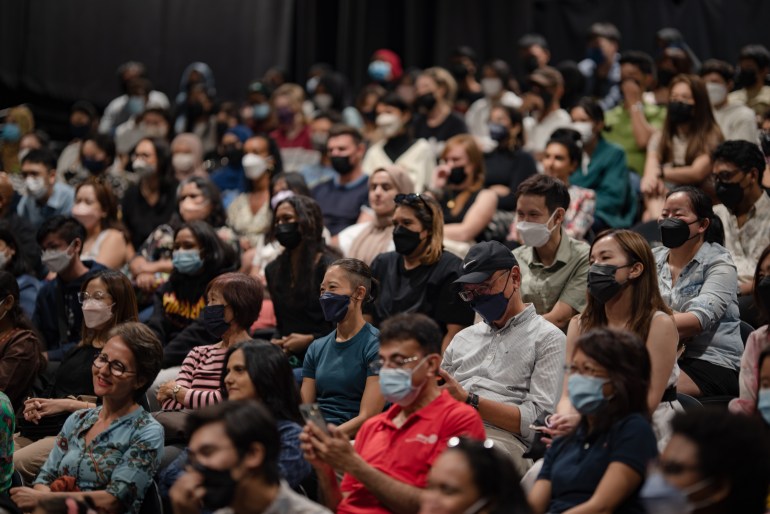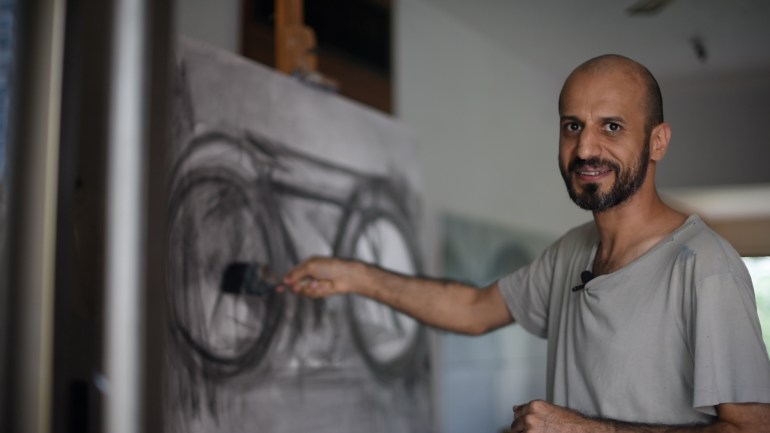In Malaysia, refugees discover that ‘theatre can be their voice’
Parastoo performing arts group gives refugees chance to challenge stereotypes and change the narrative of their lives.

Kuala Lumpur, Malaysia – As the lights go out and darkness envelops the hall, three young girls walk onto the stage under three bright lights to talk to the audience and tell the stories of three refugee girls from countries far apart, yet similar.
This scene is a part of a play by the refugee-led theatre group Parastoo, which has been performing in Malaysia’s capital Kuala Lumpur for five years. The roof that collapsed is the latest of many plays written and directed by Parastoo’s founder, Afghan writer and director Saleh Sepas, who is also a refugee.
Keep reading
list of 4 itemsUN refugee agency ‘shocked’ at Rohingya deaths in Malaysia escape
Indonesia rejects Rohingya refugees, sends boat to Malaysia
‘The virus knows no borders. Neither should our solidarity’
For two of the three girls, the play marks the first time they have performed on stage, but finding venues for the amateur group to rehearse was a challenge.
“I used to drive them to public parks to do our rehearsals. We just wanted to achieve something with this show despite the difficulties, and we did,” Sepas told Al Jazeera.
Sepas founded the refugee theatre group back in 2017, partly because he wanted to help himself as a writer, but also to help the refugees themselves.

Parastoo is based on the ideas of the Theatre of the Oppressed – a theatrical form first elaborated in the 1970s by Brazilian theatre practitioner Augusto Boal – that uses theatre as a means to promote social and political change and engages the audience in the play by inviting them to analyse and discuss what they see.
“Theatre as an art has that power to bring change, to empower and bring refugees out of isolation,” he told Al Jazeera.
“I realised that refugees in Malaysia don’t have a voice and theatre can be their voice, I wanted us to help our communities.”
Challenging stereotypes
Parastoo’s latest play tells the story of three young girls from Afghanistan, Myanmar, and Yemen, as they tell the audience how they became refugees in Malaysia. The girls share stories of war, death, loss, and trauma, with powerful words about childhoods lost to war.
The play is a part of Parastoo’s show Converging Paths, which also includes the screening of a film on refugees by Parastoo’s producer and communications adviser, Iranian filmmaker Amin Kamrani.
Sepas told Al Jazeera that he wants those watching the performance to know and understand the reasons that bring refugees to Malaysia, as many Malaysians do not understand the lack of choice they have when fleeing war.
“Some people think we come here for money and opportunity, and I wanted to challenge that misinformation about refugees,” he said.
Kamrani’s film The person within the frames also features the stories of three refugees in Malaysia – a boxer from Afghanistan, a painter from Iran, and a queer poet and writer from Syria – and offers the audience a look into their individual lives and struggles.

Kamrani says that he wanted to break stereotypes with his film. He explains that the discussion about refugees in Malaysia is often dehumanising to refugees as they are portrayed as a mass of humans with similar ideas, or reduced to figures and numbers.
“I wanted to tell human stories because as humans we connect to art, and we still see a part of ourselves in other humans regardless of differences,” he told Al Jazeera.
“Art can remind us of our values and shared experiences as humans in times of uncertainty, and I believe that being human in times of atrocity is an act of activism.”
Sepas is one of 3,000 Afghan refugees and asylum seekers currently in Malaysia. Afghans are one of the smallest communities of refugees in the country, which had nearly 183,000 refugees and asylum seekers as of May 2022, according to the UN refugee agency.
Refugees in Malaysia struggle with a lack of work and education opportunities because local laws do not recognise their existence and Malaysia is not a signatory to the UN convention. As a result, refugees are considered undocumented migrants and are deprived of the right to work or to access formal education.
In addition to their struggles, refugees in Malaysia have to go through years of waiting for potential resettlement in a third country. Such resettlement is not guaranteed and many end up in limbo with no vision for their future and uncertainty about their next destination.
Sepas describes the situation as “torturous” – noting some people have been waiting for more than 12 years – but he believes in the power of art to help refugees deal with the prolonged uncertainty in their lives.
“Imagine a boat floating in the middle of the sea and it suddenly breaks. People in the water will struggle and swim in hopes of survival, and what we are trying to do is that,” he told Al Jazeera.
“With art, we are trying to stay alive in this sea of uncertainty.”
A stage for hope
Many refugees are living with a variety of mental health issues as a result of not only the horrors that forced them to flee their home countries, but also the reality of life in host countries like Malaysia.
A 2021 study published in the medical journal The Lancet about mental health services for refugees in Malaysia during the COVID-19 pandemic found that the prevalence of mental disorders was extremely high.
“Up to 43 percent [of refugees] meeting criteria for at least one of the common mental disorders including depression, generalised anxiety, post-traumatic stress disorder, and complicated grief,” it said.
But in the face of all these challenges, Parastoo continues to make more shows that tell the stories of refugees and gives a platform for refugee actors to present themselves to diverse audiences in Malaysia.

With many shows over the years, and more to come, Sepas believes the theatre can give hope to refugees from all communities as they see their stories being told to the world on the stage.
Moreover, Parastoo is close to achieving a long-awaited dream of having its own space in Kuala Lumpur, with the launch of its new art centre later this year.
Sepas says the centre will allow Parastoo to produce more, better quality shows, and will provide a much-needed space for refugee youth to gather.
He plans to use the centre to have art, music, and writing classes and a book club for refugees.
“We want refugees to read again and reconnect to the education they’re deprived of because of legal issues,” he told Al Jazeera.
“Young refugees need a space, and they can produce great things. All they need is someone who sees the great potential in them.”